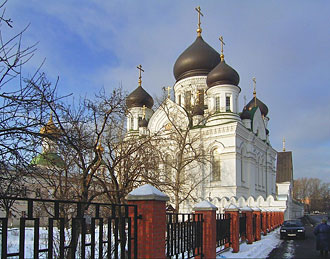 |
 This monastery, which lies in the far south of Moscow on the banks of the Moskva River, dates back to the late 14th Century, although little is known of its history until the first written mention in 1623. However, it came to prominence under the early Romanovs, and was directly connected with some of the most important figures in the Orthodox Church in the modern age. It also contains one of the last major churches to be built in the Moscow region before the Revolution - the enormous New Cathedral (The Cathedral of the Iberian Icon of the Virgin, consecrated in 1908). Services resumed in the Old Cathedral in 1991, and the monastery has since become one of the most active in Moscow.
This monastery, which lies in the far south of Moscow on the banks of the Moskva River, dates back to the late 14th Century, although little is known of its history until the first written mention in 1623. However, it came to prominence under the early Romanovs, and was directly connected with some of the most important figures in the Orthodox Church in the modern age. It also contains one of the last major churches to be built in the Moscow region before the Revolution - the enormous New Cathedral (The Cathedral of the Iberian Icon of the Virgin, consecrated in 1908). Services resumed in the Old Cathedral in 1991, and the monastery has since become one of the most active in Moscow.
The Old or St. Nicholas Cathedral was consecrated in 1700 by Patriarch Adrian, the last priest to hold the office before Peter the Great's reforms of the church, which replaced the patriarchy with a Holy Synod. Adrian established his summer residence in the monastery, and oversaw the construction of the cathedral, a layered white building in the Moscow Baroque style with an elegant bell tower and extremely rich interiors that were added in the late 18th Century under the auspices of Metropolitan Platon, who also founded a seminary in the monastery.
The New Cathedral, designed by architect Pyotr Vinogradov, was built on the instructions of Metropolitan Vladimir to honor the famous Icon of the Iberian Virgin, which from the 17th Century was housed in the specially built Iberian Chapel on Red Square. The white, black-domed cathedral, which combines neoclassical austerity with elements of Russian revivalism and has space for over 3,000 worshippers, was an extraordinary project for the time, considering the distance of the monastery from the centre of Moscow and its relative unimportance in the Church hierarchy.
Perhaps because of its distance from the city centre, the monastery was not immediately closed by the Bolshevik government. Instead, it was slowly stripped of its treasures and functions and, unlike other religious institutions, suffered its worst degradations in the post-war decades. It wasn't until the nineties that any restoration began, but the monastery is now fully working again, with a seminary and a number of charitable institutions attached to it.
|
 |

 This monastery, which lies in the far south of Moscow on the banks of the Moskva River, dates back to the late 14th Century, although little is known of its history until the first written mention in 1623. However, it came to prominence under the early Romanovs, and was directly connected with some of the most important figures in the Orthodox Church in the modern age. It also contains one of the last major churches to be built in the Moscow region before the Revolution - the enormous New Cathedral (The Cathedral of the Iberian Icon of the Virgin, consecrated in 1908). Services resumed in the Old Cathedral in 1991, and the monastery has since become one of the most active in Moscow.
This monastery, which lies in the far south of Moscow on the banks of the Moskva River, dates back to the late 14th Century, although little is known of its history until the first written mention in 1623. However, it came to prominence under the early Romanovs, and was directly connected with some of the most important figures in the Orthodox Church in the modern age. It also contains one of the last major churches to be built in the Moscow region before the Revolution - the enormous New Cathedral (The Cathedral of the Iberian Icon of the Virgin, consecrated in 1908). Services resumed in the Old Cathedral in 1991, and the monastery has since become one of the most active in Moscow.